Strategic Sustainability and Business Ethics: A Comprehensive Study
VerifiedAdded on 2023/06/03
|8
|1545
|415
Essay
AI Summary
This essay delves into the critical intersection of sustainability and business ethics, examining strategic sustainability and supply chain sustainability. It presents arguments for and against strategic sustainability, highlighting the importance of management standards, business labels, and customer requirements. The essay also discusses the potential for lack of compliance and opacity in strategic sustainability, suggesting solutions such as fair trade schemes and shared best practices. Furthermore, it explores the impact of supply chain sustainability on organizational growth and stakeholder returns, emphasizing the need for reliable resources and collaboration with stakeholders. The essay concludes that organizations prioritizing sustainability are better positioned for long-term profitability and growth, and Desklib offers a wealth of resources for further exploration of these topics.
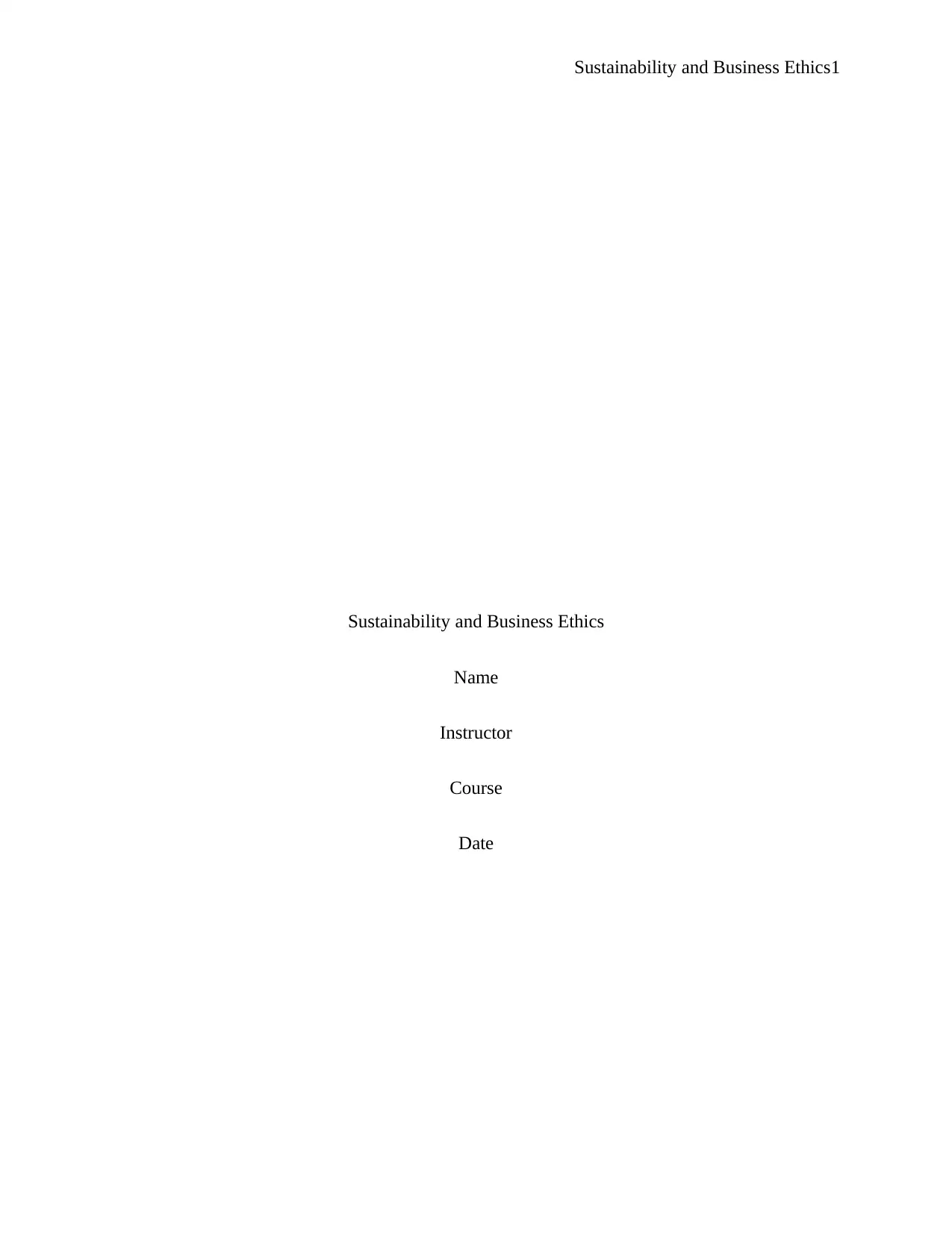
Sustainability and Business Ethics1
Sustainability and Business Ethics
Name
Instructor
Course
Date
Sustainability and Business Ethics
Name
Instructor
Course
Date
Paraphrase This Document
Need a fresh take? Get an instant paraphrase of this document with our AI Paraphraser
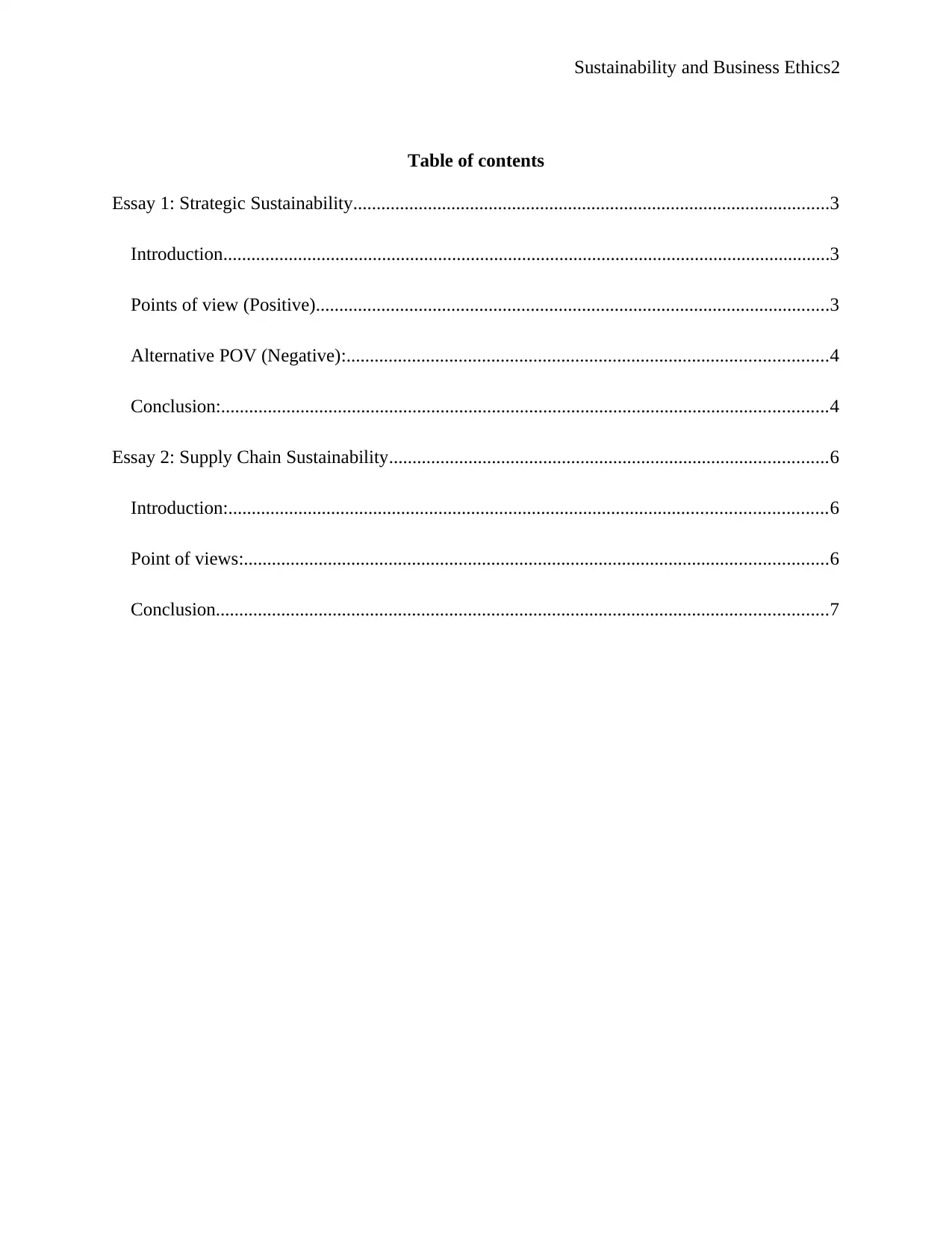
Sustainability and Business Ethics2
Table of contents
Essay 1: Strategic Sustainability......................................................................................................3
Introduction..................................................................................................................................3
Points of view (Positive)..............................................................................................................3
Alternative POV (Negative):.......................................................................................................4
Conclusion:..................................................................................................................................4
Essay 2: Supply Chain Sustainability..............................................................................................6
Introduction:................................................................................................................................6
Point of views:.............................................................................................................................6
Conclusion...................................................................................................................................7
Table of contents
Essay 1: Strategic Sustainability......................................................................................................3
Introduction..................................................................................................................................3
Points of view (Positive)..............................................................................................................3
Alternative POV (Negative):.......................................................................................................4
Conclusion:..................................................................................................................................4
Essay 2: Supply Chain Sustainability..............................................................................................6
Introduction:................................................................................................................................6
Point of views:.............................................................................................................................6
Conclusion...................................................................................................................................7
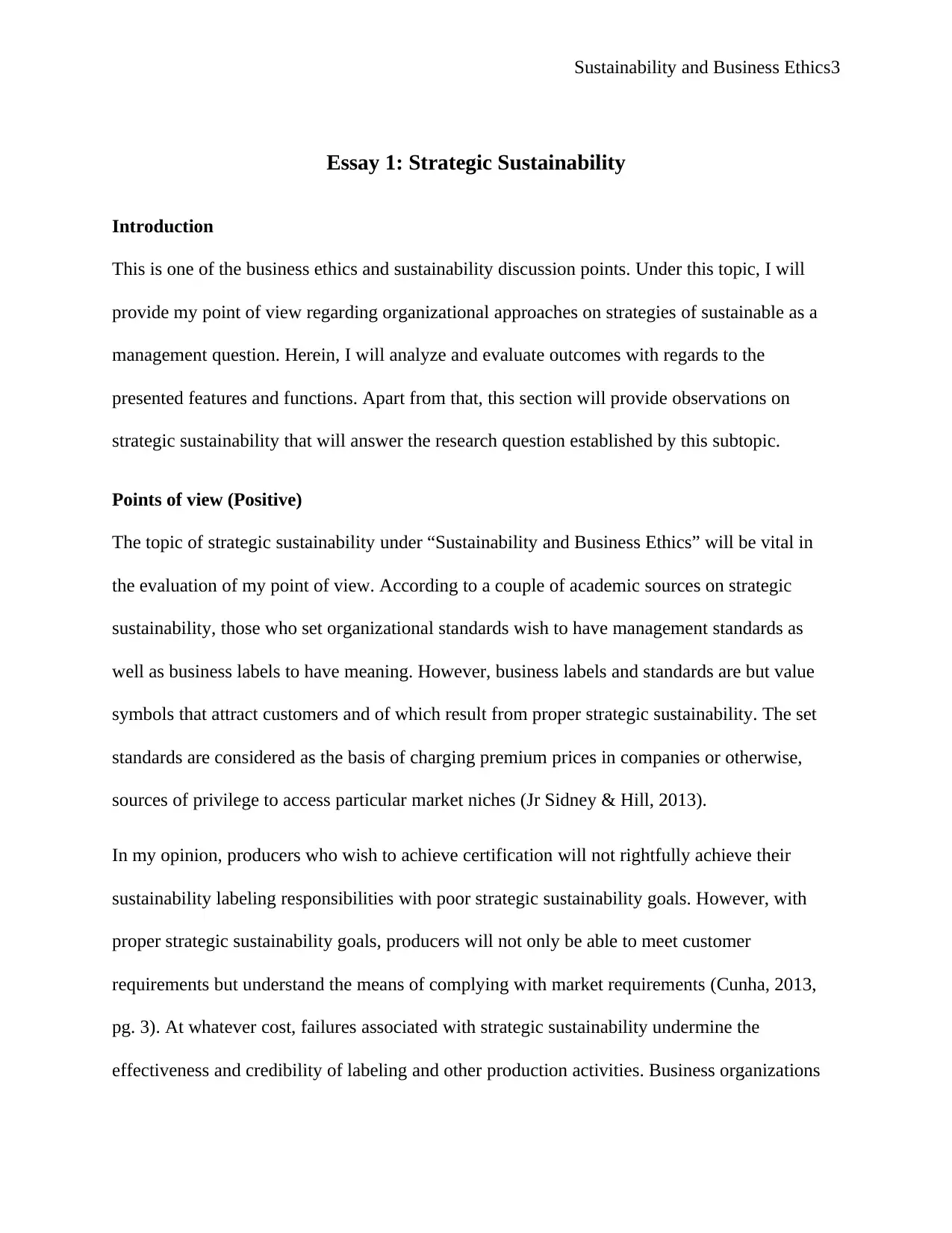
Sustainability and Business Ethics3
Essay 1: Strategic Sustainability
Introduction
This is one of the business ethics and sustainability discussion points. Under this topic, I will
provide my point of view regarding organizational approaches on strategies of sustainable as a
management question. Herein, I will analyze and evaluate outcomes with regards to the
presented features and functions. Apart from that, this section will provide observations on
strategic sustainability that will answer the research question established by this subtopic.
Points of view (Positive)
The topic of strategic sustainability under “Sustainability and Business Ethics” will be vital in
the evaluation of my point of view. According to a couple of academic sources on strategic
sustainability, those who set organizational standards wish to have management standards as
well as business labels to have meaning. However, business labels and standards are but value
symbols that attract customers and of which result from proper strategic sustainability. The set
standards are considered as the basis of charging premium prices in companies or otherwise,
sources of privilege to access particular market niches (Jr Sidney & Hill, 2013).
In my opinion, producers who wish to achieve certification will not rightfully achieve their
sustainability labeling responsibilities with poor strategic sustainability goals. However, with
proper strategic sustainability goals, producers will not only be able to meet customer
requirements but understand the means of complying with market requirements (Cunha, 2013,
pg. 3). At whatever cost, failures associated with strategic sustainability undermine the
effectiveness and credibility of labeling and other production activities. Business organizations
Essay 1: Strategic Sustainability
Introduction
This is one of the business ethics and sustainability discussion points. Under this topic, I will
provide my point of view regarding organizational approaches on strategies of sustainable as a
management question. Herein, I will analyze and evaluate outcomes with regards to the
presented features and functions. Apart from that, this section will provide observations on
strategic sustainability that will answer the research question established by this subtopic.
Points of view (Positive)
The topic of strategic sustainability under “Sustainability and Business Ethics” will be vital in
the evaluation of my point of view. According to a couple of academic sources on strategic
sustainability, those who set organizational standards wish to have management standards as
well as business labels to have meaning. However, business labels and standards are but value
symbols that attract customers and of which result from proper strategic sustainability. The set
standards are considered as the basis of charging premium prices in companies or otherwise,
sources of privilege to access particular market niches (Jr Sidney & Hill, 2013).
In my opinion, producers who wish to achieve certification will not rightfully achieve their
sustainability labeling responsibilities with poor strategic sustainability goals. However, with
proper strategic sustainability goals, producers will not only be able to meet customer
requirements but understand the means of complying with market requirements (Cunha, 2013,
pg. 3). At whatever cost, failures associated with strategic sustainability undermine the
effectiveness and credibility of labeling and other production activities. Business organizations
⊘ This is a preview!⊘
Do you want full access?
Subscribe today to unlock all pages.

Trusted by 1+ million students worldwide
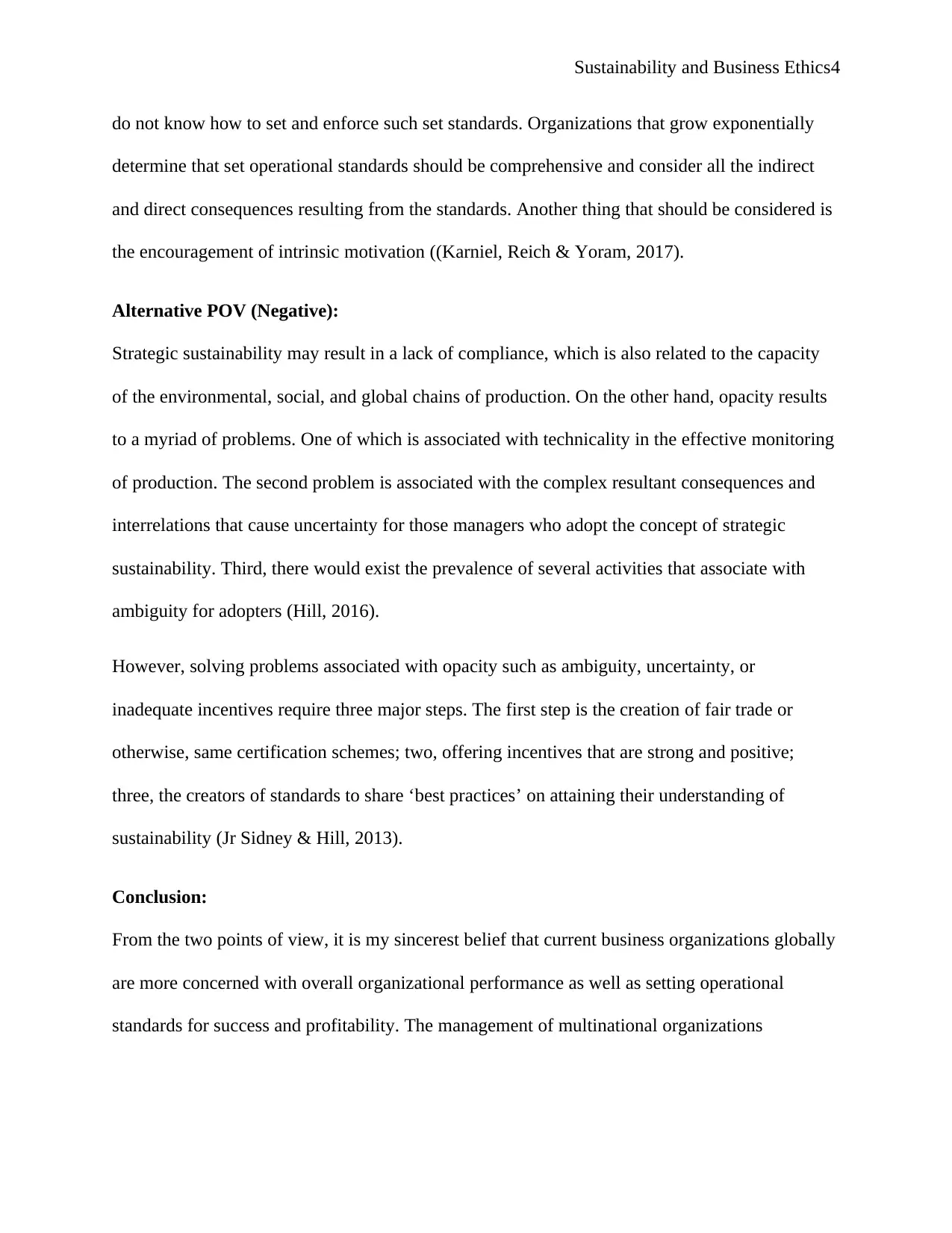
Sustainability and Business Ethics4
do not know how to set and enforce such set standards. Organizations that grow exponentially
determine that set operational standards should be comprehensive and consider all the indirect
and direct consequences resulting from the standards. Another thing that should be considered is
the encouragement of intrinsic motivation ((Karniel, Reich & Yoram, 2017).
Alternative POV (Negative):
Strategic sustainability may result in a lack of compliance, which is also related to the capacity
of the environmental, social, and global chains of production. On the other hand, opacity results
to a myriad of problems. One of which is associated with technicality in the effective monitoring
of production. The second problem is associated with the complex resultant consequences and
interrelations that cause uncertainty for those managers who adopt the concept of strategic
sustainability. Third, there would exist the prevalence of several activities that associate with
ambiguity for adopters (Hill, 2016).
However, solving problems associated with opacity such as ambiguity, uncertainty, or
inadequate incentives require three major steps. The first step is the creation of fair trade or
otherwise, same certification schemes; two, offering incentives that are strong and positive;
three, the creators of standards to share ‘best practices’ on attaining their understanding of
sustainability (Jr Sidney & Hill, 2013).
Conclusion:
From the two points of view, it is my sincerest belief that current business organizations globally
are more concerned with overall organizational performance as well as setting operational
standards for success and profitability. The management of multinational organizations
do not know how to set and enforce such set standards. Organizations that grow exponentially
determine that set operational standards should be comprehensive and consider all the indirect
and direct consequences resulting from the standards. Another thing that should be considered is
the encouragement of intrinsic motivation ((Karniel, Reich & Yoram, 2017).
Alternative POV (Negative):
Strategic sustainability may result in a lack of compliance, which is also related to the capacity
of the environmental, social, and global chains of production. On the other hand, opacity results
to a myriad of problems. One of which is associated with technicality in the effective monitoring
of production. The second problem is associated with the complex resultant consequences and
interrelations that cause uncertainty for those managers who adopt the concept of strategic
sustainability. Third, there would exist the prevalence of several activities that associate with
ambiguity for adopters (Hill, 2016).
However, solving problems associated with opacity such as ambiguity, uncertainty, or
inadequate incentives require three major steps. The first step is the creation of fair trade or
otherwise, same certification schemes; two, offering incentives that are strong and positive;
three, the creators of standards to share ‘best practices’ on attaining their understanding of
sustainability (Jr Sidney & Hill, 2013).
Conclusion:
From the two points of view, it is my sincerest belief that current business organizations globally
are more concerned with overall organizational performance as well as setting operational
standards for success and profitability. The management of multinational organizations
Paraphrase This Document
Need a fresh take? Get an instant paraphrase of this document with our AI Paraphraser
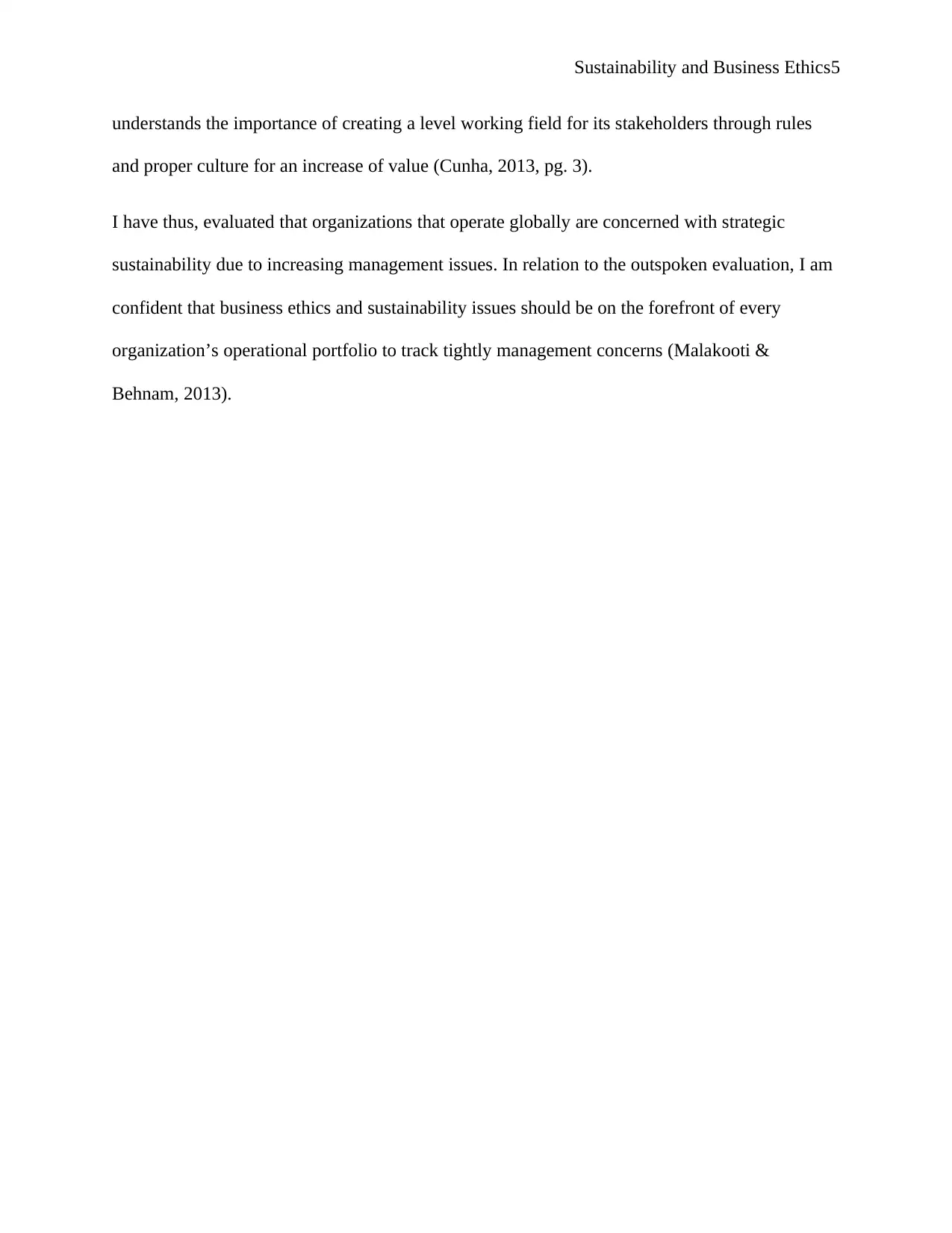
Sustainability and Business Ethics5
understands the importance of creating a level working field for its stakeholders through rules
and proper culture for an increase of value (Cunha, 2013, pg. 3).
I have thus, evaluated that organizations that operate globally are concerned with strategic
sustainability due to increasing management issues. In relation to the outspoken evaluation, I am
confident that business ethics and sustainability issues should be on the forefront of every
organization’s operational portfolio to track tightly management concerns (Malakooti &
Behnam, 2013).
understands the importance of creating a level working field for its stakeholders through rules
and proper culture for an increase of value (Cunha, 2013, pg. 3).
I have thus, evaluated that organizations that operate globally are concerned with strategic
sustainability due to increasing management issues. In relation to the outspoken evaluation, I am
confident that business ethics and sustainability issues should be on the forefront of every
organization’s operational portfolio to track tightly management concerns (Malakooti &
Behnam, 2013).
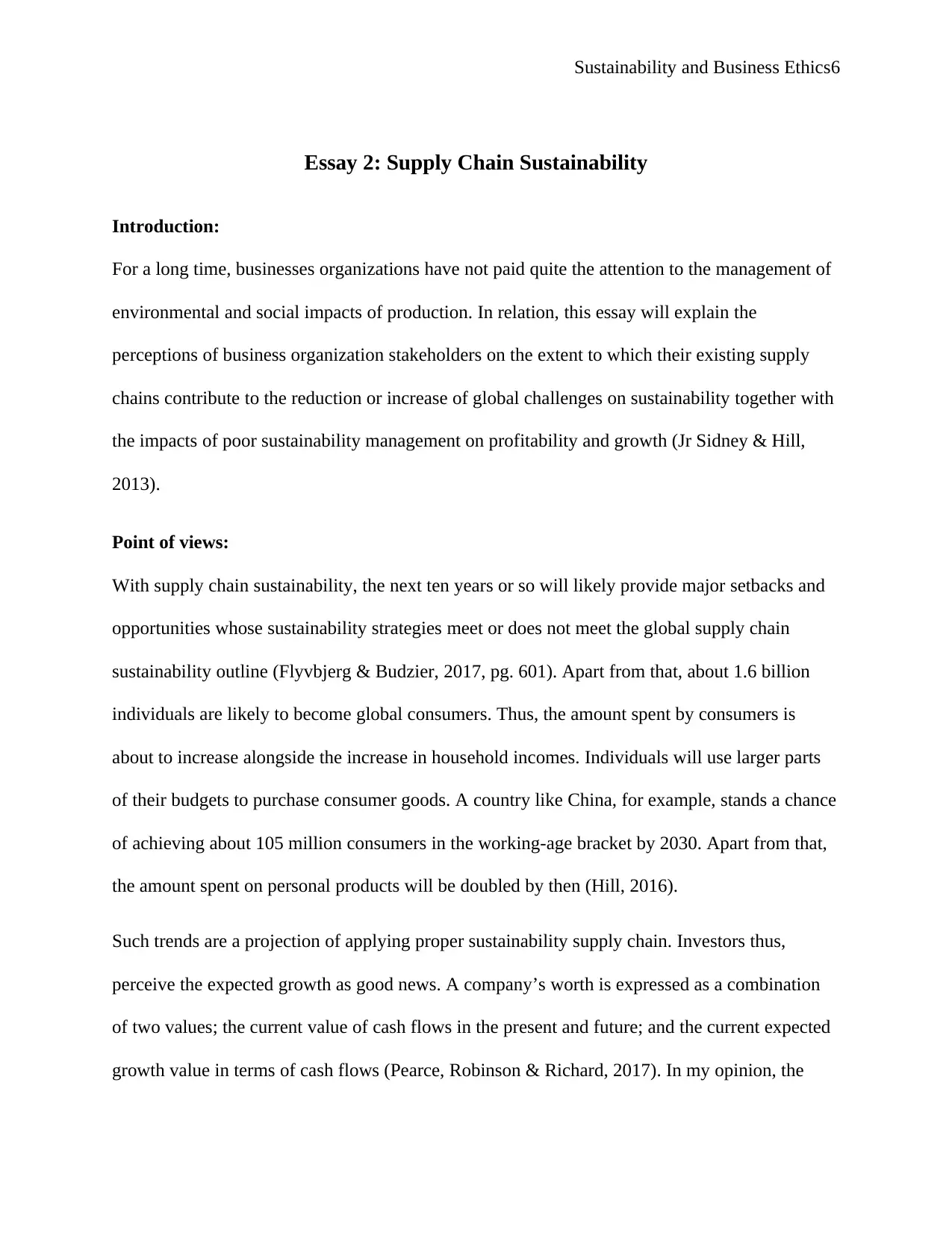
Sustainability and Business Ethics6
Essay 2: Supply Chain Sustainability
Introduction:
For a long time, businesses organizations have not paid quite the attention to the management of
environmental and social impacts of production. In relation, this essay will explain the
perceptions of business organization stakeholders on the extent to which their existing supply
chains contribute to the reduction or increase of global challenges on sustainability together with
the impacts of poor sustainability management on profitability and growth (Jr Sidney & Hill,
2013).
Point of views:
With supply chain sustainability, the next ten years or so will likely provide major setbacks and
opportunities whose sustainability strategies meet or does not meet the global supply chain
sustainability outline (Flyvbjerg & Budzier, 2017, pg. 601). Apart from that, about 1.6 billion
individuals are likely to become global consumers. Thus, the amount spent by consumers is
about to increase alongside the increase in household incomes. Individuals will use larger parts
of their budgets to purchase consumer goods. A country like China, for example, stands a chance
of achieving about 105 million consumers in the working-age bracket by 2030. Apart from that,
the amount spent on personal products will be doubled by then (Hill, 2016).
Such trends are a projection of applying proper sustainability supply chain. Investors thus,
perceive the expected growth as good news. A company’s worth is expressed as a combination
of two values; the current value of cash flows in the present and future; and the current expected
growth value in terms of cash flows (Pearce, Robinson & Richard, 2017). In my opinion, the
Essay 2: Supply Chain Sustainability
Introduction:
For a long time, businesses organizations have not paid quite the attention to the management of
environmental and social impacts of production. In relation, this essay will explain the
perceptions of business organization stakeholders on the extent to which their existing supply
chains contribute to the reduction or increase of global challenges on sustainability together with
the impacts of poor sustainability management on profitability and growth (Jr Sidney & Hill,
2013).
Point of views:
With supply chain sustainability, the next ten years or so will likely provide major setbacks and
opportunities whose sustainability strategies meet or does not meet the global supply chain
sustainability outline (Flyvbjerg & Budzier, 2017, pg. 601). Apart from that, about 1.6 billion
individuals are likely to become global consumers. Thus, the amount spent by consumers is
about to increase alongside the increase in household incomes. Individuals will use larger parts
of their budgets to purchase consumer goods. A country like China, for example, stands a chance
of achieving about 105 million consumers in the working-age bracket by 2030. Apart from that,
the amount spent on personal products will be doubled by then (Hill, 2016).
Such trends are a projection of applying proper sustainability supply chain. Investors thus,
perceive the expected growth as good news. A company’s worth is expressed as a combination
of two values; the current value of cash flows in the present and future; and the current expected
growth value in terms of cash flows (Pearce, Robinson & Richard, 2017). In my opinion, the
⊘ This is a preview!⊘
Do you want full access?
Subscribe today to unlock all pages.

Trusted by 1+ million students worldwide
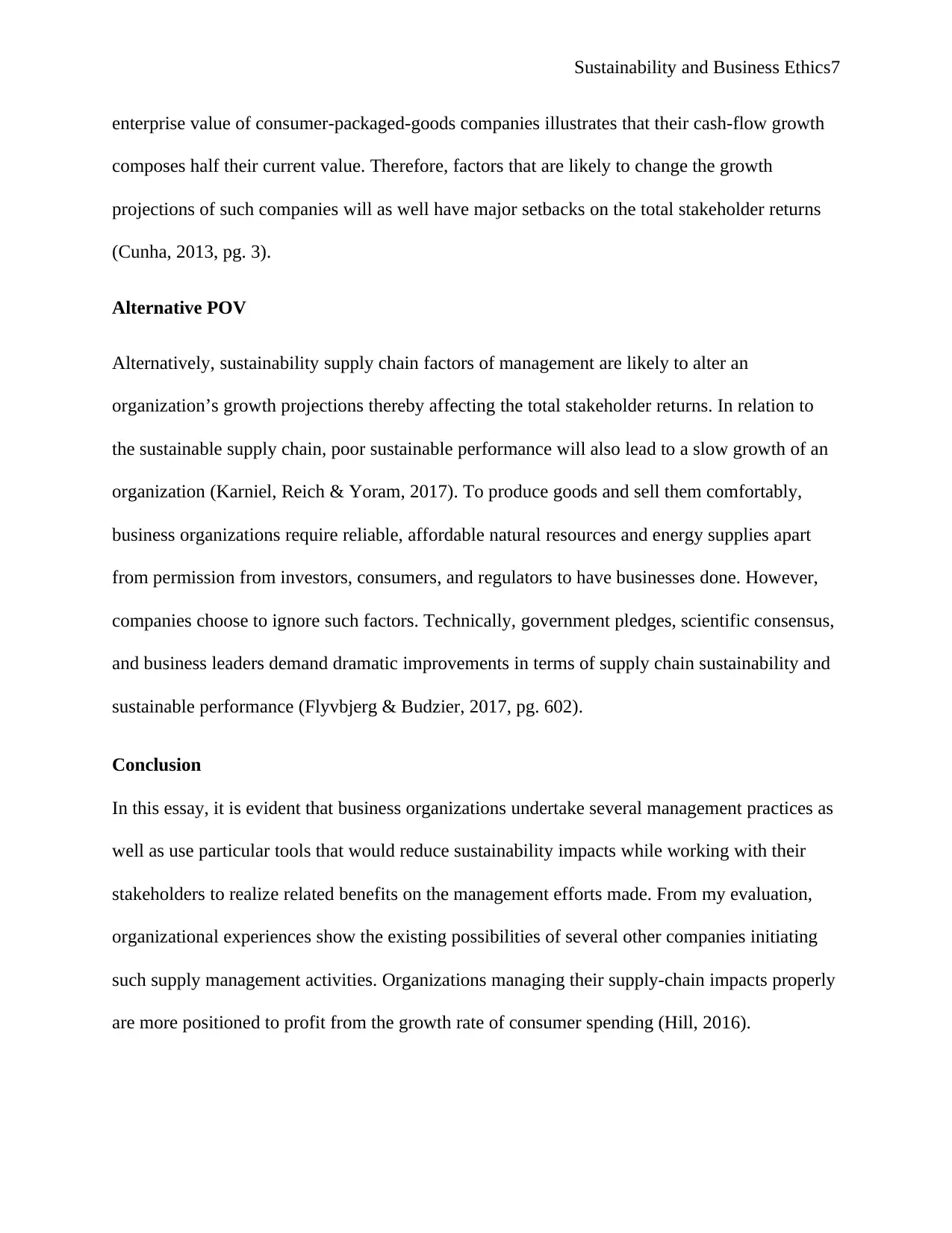
Sustainability and Business Ethics7
enterprise value of consumer-packaged-goods companies illustrates that their cash-flow growth
composes half their current value. Therefore, factors that are likely to change the growth
projections of such companies will as well have major setbacks on the total stakeholder returns
(Cunha, 2013, pg. 3).
Alternative POV
Alternatively, sustainability supply chain factors of management are likely to alter an
organization’s growth projections thereby affecting the total stakeholder returns. In relation to
the sustainable supply chain, poor sustainable performance will also lead to a slow growth of an
organization (Karniel, Reich & Yoram, 2017). To produce goods and sell them comfortably,
business organizations require reliable, affordable natural resources and energy supplies apart
from permission from investors, consumers, and regulators to have businesses done. However,
companies choose to ignore such factors. Technically, government pledges, scientific consensus,
and business leaders demand dramatic improvements in terms of supply chain sustainability and
sustainable performance (Flyvbjerg & Budzier, 2017, pg. 602).
Conclusion
In this essay, it is evident that business organizations undertake several management practices as
well as use particular tools that would reduce sustainability impacts while working with their
stakeholders to realize related benefits on the management efforts made. From my evaluation,
organizational experiences show the existing possibilities of several other companies initiating
such supply management activities. Organizations managing their supply-chain impacts properly
are more positioned to profit from the growth rate of consumer spending (Hill, 2016).
enterprise value of consumer-packaged-goods companies illustrates that their cash-flow growth
composes half their current value. Therefore, factors that are likely to change the growth
projections of such companies will as well have major setbacks on the total stakeholder returns
(Cunha, 2013, pg. 3).
Alternative POV
Alternatively, sustainability supply chain factors of management are likely to alter an
organization’s growth projections thereby affecting the total stakeholder returns. In relation to
the sustainable supply chain, poor sustainable performance will also lead to a slow growth of an
organization (Karniel, Reich & Yoram, 2017). To produce goods and sell them comfortably,
business organizations require reliable, affordable natural resources and energy supplies apart
from permission from investors, consumers, and regulators to have businesses done. However,
companies choose to ignore such factors. Technically, government pledges, scientific consensus,
and business leaders demand dramatic improvements in terms of supply chain sustainability and
sustainable performance (Flyvbjerg & Budzier, 2017, pg. 602).
Conclusion
In this essay, it is evident that business organizations undertake several management practices as
well as use particular tools that would reduce sustainability impacts while working with their
stakeholders to realize related benefits on the management efforts made. From my evaluation,
organizational experiences show the existing possibilities of several other companies initiating
such supply management activities. Organizations managing their supply-chain impacts properly
are more positioned to profit from the growth rate of consumer spending (Hill, 2016).
Paraphrase This Document
Need a fresh take? Get an instant paraphrase of this document with our AI Paraphraser
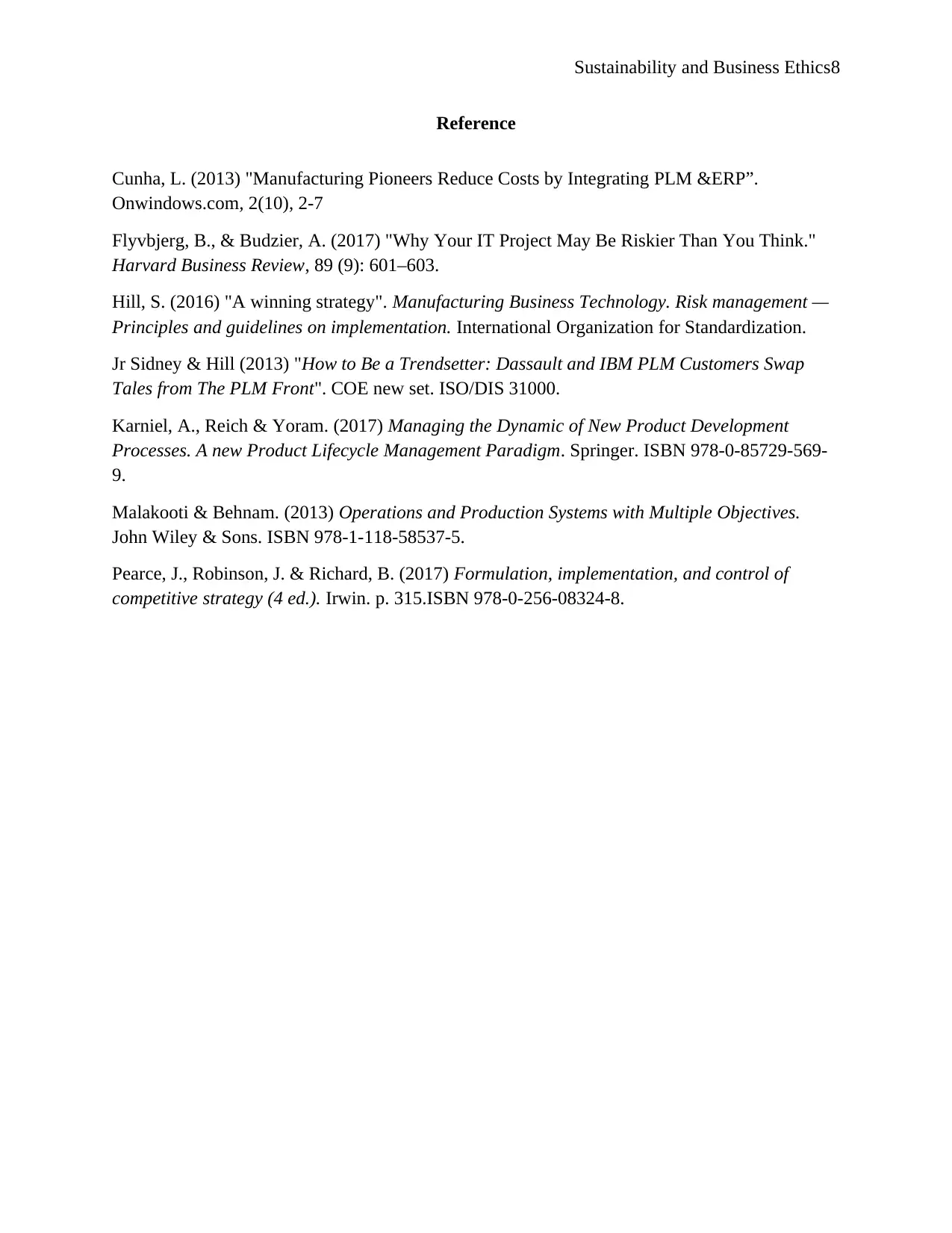
Sustainability and Business Ethics8
Reference
Cunha, L. (2013) "Manufacturing Pioneers Reduce Costs by Integrating PLM &ERP”.
Onwindows.com, 2(10), 2-7
Flyvbjerg, B., & Budzier, A. (2017) "Why Your IT Project May Be Riskier Than You Think."
Harvard Business Review, 89 (9): 601–603.
Hill, S. (2016) "A winning strategy". Manufacturing Business Technology. Risk management —
Principles and guidelines on implementation. International Organization for Standardization.
Jr Sidney & Hill (2013) "How to Be a Trendsetter: Dassault and IBM PLM Customers Swap
Tales from The PLM Front". COE new set. ISO/DIS 31000.
Karniel, A., Reich & Yoram. (2017) Managing the Dynamic of New Product Development
Processes. A new Product Lifecycle Management Paradigm. Springer. ISBN 978-0-85729-569-
9.
Malakooti & Behnam. (2013) Operations and Production Systems with Multiple Objectives.
John Wiley & Sons. ISBN 978-1-118-58537-5.
Pearce, J., Robinson, J. & Richard, B. (2017) Formulation, implementation, and control of
competitive strategy (4 ed.). Irwin. p. 315.ISBN 978-0-256-08324-8.
Reference
Cunha, L. (2013) "Manufacturing Pioneers Reduce Costs by Integrating PLM &ERP”.
Onwindows.com, 2(10), 2-7
Flyvbjerg, B., & Budzier, A. (2017) "Why Your IT Project May Be Riskier Than You Think."
Harvard Business Review, 89 (9): 601–603.
Hill, S. (2016) "A winning strategy". Manufacturing Business Technology. Risk management —
Principles and guidelines on implementation. International Organization for Standardization.
Jr Sidney & Hill (2013) "How to Be a Trendsetter: Dassault and IBM PLM Customers Swap
Tales from The PLM Front". COE new set. ISO/DIS 31000.
Karniel, A., Reich & Yoram. (2017) Managing the Dynamic of New Product Development
Processes. A new Product Lifecycle Management Paradigm. Springer. ISBN 978-0-85729-569-
9.
Malakooti & Behnam. (2013) Operations and Production Systems with Multiple Objectives.
John Wiley & Sons. ISBN 978-1-118-58537-5.
Pearce, J., Robinson, J. & Richard, B. (2017) Formulation, implementation, and control of
competitive strategy (4 ed.). Irwin. p. 315.ISBN 978-0-256-08324-8.
1 out of 8
Your All-in-One AI-Powered Toolkit for Academic Success.
+13062052269
info@desklib.com
Available 24*7 on WhatsApp / Email
![[object Object]](/_next/static/media/star-bottom.7253800d.svg)
Unlock your academic potential
Copyright © 2020–2025 A2Z Services. All Rights Reserved. Developed and managed by ZUCOL.